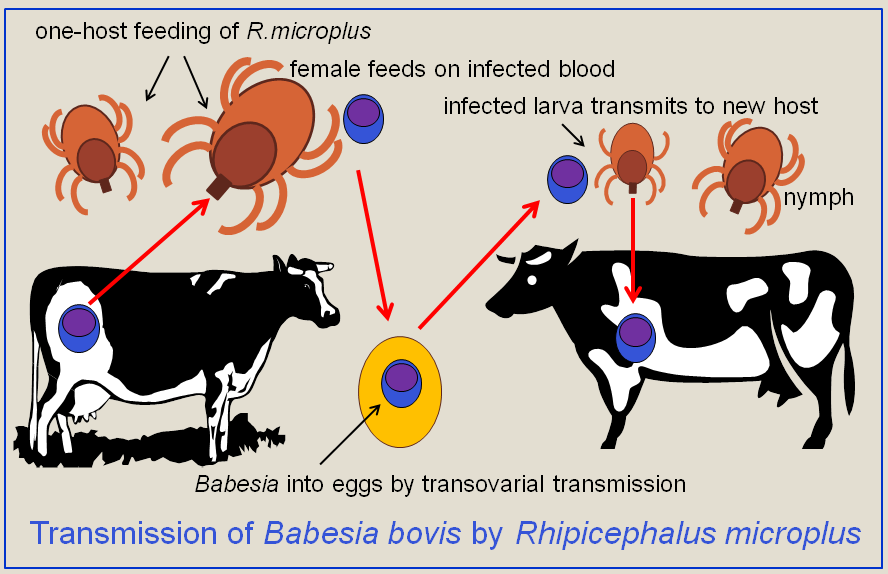|
Babesia Bigemina
''Babesia bigemina'' is a species of alveolates belonging to the phylum Apicomplexa and the family Babesiidae, a type of protozoan parasite. In cattle, it causes babesiosis Babesiosis or piroplasmosis is a malaria-like parasitic disease caused by infection with a eukaryotic parasite in the order Piroplasmida, typically a ''Babesia'' or '' Theileria'', in the phylum Apicomplexa. Human babesiosis transmission via ..., also called "Texas fever". Its length is 4–5 µm and its width is 2–3 µm. Usually, it has an oval shape. In blood cells, it is located midsagittally and can reach up to two-thirds of the diameter of the blood cell in size. It is transmitted by ''Boophilus'' ticks which are prevalent in the tropics. The genome for ''B. bigemina'' is incomplete and unassembled. Further reading * * * bigemina Species described in 1926 Parasites of mammals {{Apicomplexa-stub ... [...More Info...] [...Related Items...] OR: [Wikipedia] [Google] [Baidu] |
Apicomplexa
The Apicomplexa (also called Apicomplexia) are a large phylum of parasitic alveolates. Most of them possess a unique form of organelle that comprises a type of non-photosynthetic plastid called an apicoplast, and an apical complex structure. The organelle is an adaptation that the apicomplexan applies in penetration of a host cell. The Apicomplexa are unicellular and spore-forming. All species are obligate endoparasites of animals, except '' Nephromyces'', a symbiont in marine animals, originally classified as a chytrid fungus. Motile structures such as flagella or pseudopods are present only in certain gamete stages. The Apicomplexa are a diverse group that includes organisms such as the coccidia, gregarines, piroplasms, haemogregarines, and plasmodia. Diseases caused by Apicomplexa include: * Babesiosis (''Babesia'') * Malaria (''Plasmodium'') * Cryptosporidiosis (''Cryptosporidium parvum'') * Cyclosporiasis (''Cyclospora cayetanensis'') * Cystoisosporiasis (''Cystoisosp ... [...More Info...] [...Related Items...] OR: [Wikipedia] [Google] [Baidu] |
Babesiidae
Babesiidae is a family of protists belonging to the order Piroplasmida. Genera: * ''Babesia ''Babesia'', also called ''Nuttallia'', is an apicomplexan parasite that infects red blood cells and is transmitted by ticks. Originally discovered by the Romanian bacteriologist Victor Babeș in 1888, over 100 species of ''Babesia'' have since ...'' Starcovivi, 1893 * '' Echinozoon'' Garnham, 1951 References {{Taxonbar, from=Q18618857 Piroplasmida ... [...More Info...] [...Related Items...] OR: [Wikipedia] [Google] [Baidu] |
Babesiosis
Babesiosis or piroplasmosis is a malaria-like parasitic disease caused by infection with a eukaryotic parasite in the order Piroplasmida, typically a ''Babesia'' or ''Theileria'', in the phylum Apicomplexa. Human babesiosis transmission via tick bite is most common in the Northeastern and Midwestern United States and parts of Europe, and sporadic throughout the rest of the world. It occurs in warm weather. People can get infected with ''Babesia'' parasites by the bite of an infected tick, by getting a blood transfusion from an infected donor of blood products, or by congenital transmission (an infected mother to her baby). Ticks transmit the human strain of babesiosis, so it often presents with other tick-borne illnesses such as Lyme disease. After trypanosomes, ''Babesia'' is thought to be the second-most common blood parasite of mammals. They can have major adverse effects on the health of domestic animals in areas without severe winters. In cattle the disease is known as T ... [...More Info...] [...Related Items...] OR: [Wikipedia] [Google] [Baidu] |
Babesia
''Babesia'', also called ''Nuttallia'', is an apicomplexan parasite that infects red blood cells and is transmitted by ticks. Originally discovered by the Romanian bacteriologist Victor Babeș in 1888, over 100 species of ''Babesia'' have since been identified. ''Babesia'' comprises more than 100 species of tick-borne parasites that infect erythrocytes (red blood cells) in many vertebrate hosts. ''Babesia'' species infect livestock worldwide, wild and domestic vertebrate animals, and occasionally humans, where they cause the disease babesiosis. In the United States, ''B. microti'' is the most common strain of the few which have been documented to cause disease in humans. Classification ''Babesia'' is a protozoan parasite found to infect vertebrate animals, mostly livestock mammals and birds, but also occasionally humans. Common names of the disease that ''Babesia microti'' causes are Texas cattle fever, redwater fever, tick fever, and Nantucket fever. The disease it caus ... [...More Info...] [...Related Items...] OR: [Wikipedia] [Google] [Baidu] |
Species Described In 1926
In biology, a species is the basic unit of classification and a taxonomic rank of an organism, as well as a unit of biodiversity. A species is often defined as the largest group of organisms in which any two individuals of the appropriate sexes or mating types can produce fertile offspring, typically by sexual reproduction. Other ways of defining species include their karyotype, DNA sequence, morphology, behaviour or ecological niche. In addition, paleontologists use the concept of the chronospecies since fossil reproduction cannot be examined. The most recent rigorous estimate for the total number of species of eukaryotes is between 8 and 8.7 million. However, only about 14% of these had been described by 2011. All species (except viruses) are given a two-part name, a "binomial". The first part of a binomial is the genus to which the species belongs. The second part is called the specific name or the specific epithet (in botanical nomenclature, also sometimes in zoological ... [...More Info...] [...Related Items...] OR: [Wikipedia] [Google] [Baidu] |

